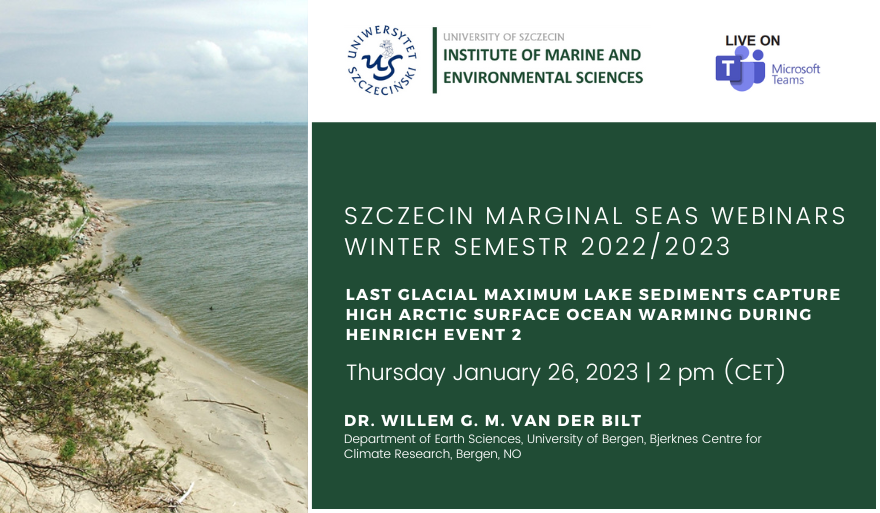
INoMiŚ zaprasza na wykład
Instytut Nauk o Morzu i Środowisku oraz Sekcja Geologii Morza Komitetu Badań Morza Polskiej Akademii Nauk i DDE Marginal Seas Task Group zapraszają na dodatkowe spotkanie naukowe cyklu Szczecin Marginal Seas Webinars, które odbędzie się w czwartek 26 stycznia 2023 r.
Tym razem gościem Instytutu Nauk o Morzu i Środowisku US będzie badacz wpływu zmian klimatycznych na stabilność pokrywy lodowej w Arktyce, Dr Willem G. M. van der Bilt z Department of Earth Sciences, University of Bergen i Bjerknes Centre for Climate Research, Bergen (NO), który wygłosi referat pt. „Last Glacial Maximum lake sediments capture High Arctic surface ocean warming during Heinrich Event 2″.
Spotkanie odbędzie się w czwartek 26 stycznia 2023 r. w formie hybrydowej, w sali nr 111 budynku przy ul. Mickiewicza 16 oraz online za pośrednictwem MS Teams.
Kod do spotkania: 2sc5rph
Abstract
Throughout the Last Glacial period, widespread deposition of Ice Rafted Debris (IRD) marks phases of North Atlantic ice sheet instability during cold Stadial conditions. The causes for these so-called Heinrich Events (HEs) remain debated: while initially attributed to internal ice sheet dynamics, there is mounting evidence for an external ocean-climate forcing. In the latter scenario, ice rafting is thought to be driven by basal melt from a build-up of sub-surface heat in response to weakening ocean circulation. However, coeval shifts from perennial to seasonal sea ice conditions suggest that some heat may have escaped to the surface. We strengthen this notion, by presenting biomarker-based evidence for atmospheric warming from a unique Last Glacial Maximum (30-20 ka BP) lake sediment sequence from High Arctic Svalbard. Alkenone-derived changes in temperature (UK37) and hydroclimate (δD) indicate a rapid shift towards warmer surface conditions and more locally sourced precipitation at the onset of HE 2. These findings are supported by XRF evidence for lake water stratification and a shift towards n-alkane distributions indicative of less arid conditions. In conclusion, our data suggests that climate-forced Arctic ice sheet instability during HEs was triggered from below as well as above.







